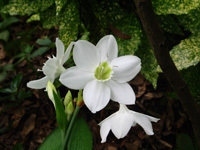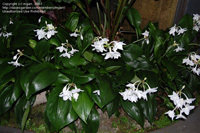





The Amazon lily is a tropical bulb that produces clusters of fragrant, star-shaped white flowers up to three times a year. Although hardy only in tropical regions, it is an excellent houseplant that can add beauty to interiorscapes anywhere in the world.
Hailing from moist, shady forests of Central and South America, the Amazon lilies are members of the Amaryllidaceae (Amaryllis) family according to most taxonomists, although it is sometimes assigned to the Liliaceae. The word "eucharis" comes from the Green eu-, meaning "good, true, original," and charis, meaning "loveliness, grace, and favor." It seems well-named, judging from this description. GRIN1 (Germplasm Resources Information Network) lists six species of Eucharis, including E. amazonica, E. candida, E. castelnaeana, E. ×grandiflora, E. moorei, and E. sanderi. Other sources list many more species2.
Species Uncertainty
I believe that the plant I have is Eucharis amazonica. According to some references, it is different from E. ×grandiflora in that it is sterile and does not produce viable seeds. The × in E. ×grandiflora indicates that it is a hybrid, or cross between two species; reportedly E. moorei and E. sanderi. The observable differences lie in the measurements of the staminal cups and other minutiae. Such differences are certainly hard to distinguish if you are a simple gardener who has been given a bulb of this plant and no certain identification. Even the experts seem confused as to the differences between these two species, but Dr. Alan W. Meerow, after years of research and study, seems to have it all ironed out. Now I wish that Dr. Meerow could see my plant and identify it positively for me. Meanwhile, I'll just call it my Amazon or eucharis lily.
 The flowers of the Amazon lily are quite arresting. Held on strong scapes well above the foliage, each terminal umbel (cluster) contains 3 to 6 waxy, fragrant flowers. The prominent corona is sometimes tinged with green, and the floral parts except for the style, are fused. The shape of the flowers is somewhat suggestive of a white narcissus.
The flowers of the Amazon lily are quite arresting. Held on strong scapes well above the foliage, each terminal umbel (cluster) contains 3 to 6 waxy, fragrant flowers. The prominent corona is sometimes tinged with green, and the floral parts except for the style, are fused. The shape of the flowers is somewhat suggestive of a white narcissus.
Adding to the allure of the plant are the large, glossy, elliptic to oval leaves on long petioles that provide a perfect foil for the showy flowers. Leaves may be several inches wide, and they form a tight rosette that arises from the bulb.
Growing Amazon Lily
Plant your Amazon lily outside in a shady place if you live in Zones 10-11. Elsewhere, it must be grown as a container plant and moved to protected places during the winter. Although it thrives in regions where the temperature hovers between 60 and 70°F, it can tolerate much warmer temperatures. Temperatures below 55°F however, may prove harmful.
Amazon lily prefers a well-drained potting mix that is rich in organic matter. Keep the soil evenly moist, and feed regularly during the growing season for best results. Plants generally bloom at least once a year. However, allowing the plant to dry out just a bit and withholding fertilizer can induce additional bloom.
Like other bulbs, the Amazon lily produces offsets. These can be removed and planted in other pots. However, let the bulbs reproduce until the container is full, and divide only when they become pot bound and seem to be ready to break the container. The lilies dislike being disturbed and pout a bit after being repotted. They can live in the original pot for several years.
Three to five bulbs in a six-inch container is about right to begin with. As with other members of the family, the bulb should be planted with their necks at or slightly above the soil surface. Keep your Amazon lily in bright light but out of direct sun. It thrives in places with high humidity and blooms best when pot bound.
Keep a lookout for such pests as caterpillars, spider mites, scale insects, and bulb mites. Caterpillars can chew unsightly holes in the leaves, and spider mites can cause the leaves to become stipled and loose much of their gloss. Slugs and snails will dine on the foliage if given a chance.
Showing Amazon Lily
I once entered my Amazon lily in a flower show. Since I was serving as clerk in that particular show, I was able to overhear the judges' discussion. Some of them thought that an untreated leaf could not possibly be that glossy and argued that glossiness had been enhanced by the addition of a leaf-shine product. That, of course, is not allowed in a Standard Flower Show. It was only after much discussion and consultation with the horticulture chairman that they decided correctly that the glistening leaves of my plant were natural.
Gardeners in tropical zones will find that the Amazon lily can be used as a substitute for Hosta, and perhaps even for Narcissus. I have discovered that the flowers are long-lasting when cut, and that they are excellent corsage flowers. The plant is an attractive houseplant even out of bloom as the leaves radiate out from the base and provide a fullness that fills a space effectively and has significant "presence."
If you hanker to add this lovely plant to your collection, you might find it in catalogs and on-line websites or at your favorite garden center. Three sources are listed on Dave's Garden PlantScout, and several Dave's Garden members have it to trade.
1USDA, ARS, National Genetic Resources Program.
Germplasm Resources Information Network - (GRIN) [Online Database].
National Germplasm Resources Laboratory, Beltsville, Maryland.
URL: http://www.ars-grin.gov/cgi-bin/npgs/html/index.pl (09 May 2010)
2http://en.wikipedia.org/wiki/Eucharis_(plant)
Thanks to mgarr of Dave's Garden for her image of Eucharis lily.Copyright © www.100flowers.win Botanic Garden All Rights Reserved